
Welcome to Hyperion Records, a British classical label devoted to presenting high-quality recordings of music of all styles and from all periods from the twelfth century to the twenty-first.
Hyperion offers both CDs, and downloads in a number of formats. The site is also available in several languages.
Please use the dropdown buttons to set your preferred options, or use the checkbox to accept the defaults.

The Te Deum and Jubilate are of course very different to the more famous 1694 settings in D major (recorded on Disc 2), for the B flat service was not written for a grand public celebration of St Cecilia’s Day. But the earlier setting is nonetheless beautifully crafted, alternating sections of chorus and verse and adding further variety in the choral sections with antiphonal effects between the two ‘sides’ of the choir, decani and cantoris. Purcell also skilfully colours his text by the allocation of his forces: in the Te Deum the lower solo trio sing ‘To thee all angels cry aloud’, the three upper voices (two trebles and a tenor) depict the ‘Cherubin and Seraphim’ (two of the highest of the nine orders of angels, associated respectively with knowledge and love) and the full choir take on the role of the Heavenly Host and their continual cries of ‘Holy, Lord God of Sabaoth’.
Purcell relaxes the mood for the more reflective central section of the Te Deum ‘When thou took’st upon thee’ and the chorus that follows, especially the setting of ‘We therefore pray thee’ is particularly effective. At ‘Vouchsafe, O Lord’ (for which in the 1694 setting Purcell produced one of his very greatest movements) Purcell changes the soloists’ distribution, adding a second bass and creating the only moment when treble and bass soloists sing together. The result is especially touching. The Jubilate has a text considerably shorter than the Te Deum and Purcell’s aim is, again, to get through the text speedily. At ‘O go your way into his gates’ he skilfully incorporates a double canon in contrary motion — ‘per arsin et thesin’: the trebles exactly copy the tenor line but in inversion, and the altos do the same with the separate line first heard in the basses. There is one short section of verse, ‘For the Lord is gracious’, which is heard before the concluding Gloria.
from notes by Robert King ©
Le Te Deum et Jubilate sont, bien entendu, bien différents des arrangements plus célèbres de 1694 en ré majeur (enregistrés sur CDA66609), car le service en si bémol ne fut pas composé pour une grande commémoration publique de la Fête de Sainte Cécile. Mais cela n'empêche pas la première mise en musique d'être superbement travaillée, alternant des sections de choeurs et de versets, et ajoutant davantage de variété dans les sections chorales avec des effets d'antiphonie entre les deux ‘côtés’ du choeur, Decani et Cantoris. Purcell colore aussi admirablement son texte par l'allocation de ses effectifs; dans le Te deum, le trio solo inférieur chante ‘To thee all angels cry aloud’, tandis que les trois voix supérieures (deux sopranos et un ténor) décrivent les ‘Chérubins et Séraphins’ (deux des plus hauts parmi les neuf choeurs des anges, associés respectivement au savoir et à l'amour) et le choeur entier assume le rôle du Corps Céleste avec les appels répétés de ‘Holy, Lord God of Sabaoth’. Purcell crée une ambiance plus détendue pour la section centrale plus pensive du Te Deum ‘When thou took'st upon thee’ (Quand Tu décidas) et le choeur qui suit, particulièrement la mise en musique de ‘We therefore pray thee’ (Nous Te prions donc), est tout à fait émouvante. A ‘Vouchsafe O Lord’ (Accorde, O Seigneur) (pour laquelle Purcell composa, dans la mise en musique de 1694, un de ses plus splendides mouvements), le compositeur change la répartition des solistes, ajoutant une seconde basse et créant la seule occasion où un soliste soprano et un soliste basse chantent ensemble. Le résultat est particulièrement touchant. Le texte du Jubilate est considérablement moins long que celui du Te Deum et le but de Purcell est ici aussi de faire passer le texte aussi rapidement que possible. A ‘O go your way into his gates’, il incorpore astucieusement un double canon en mouvement contraire — ‘per arsin et thesin’; les sopranos copient exactement la ligne ténor, mais renversée, et les altos font de même avec la ligne séparée que l'on entend d'abord dans les basses. Il y a une courte section de versets, ‘For the Lord is gracious’, que l'on entend avant le Gloria final.
extrait des notes rédigées par Robert King © 1994
Français: Alain Midoux
Te Deum und Jubilate unterscheiden sich natürlich stark von der 1694 entstandenen bekannteren Vertonung in D-Dur (eingespielt auf CDA66609), denn die B-Dur-Messe ist nicht für eine große öffentliche Feier wie die zum Festtag der Hl. Cäcilie geschrieben. Dennoch ist die ältere Vertonung wunderschön abgefaßt. Sie alterniert chorische und strophische Passagen und gewinnt in den Chorpassagen zusätzlichen Reiz durch Antiphoneffekte zwischen den beiden ‘Seiten’ des Chors, den Decani und den Cantores. Außerdem nuanciert Purcell gekonnt seinen Text, indem er die verfügbaren Kräfte aufteilt: Im Te Deum singen die drei tiefen Solostimmen ‘To thee all angels cry aloud’ [dir rufen die Engel alle zu], die drei Oberstimmen stellen die ‘Kerubim und Serafim’ dar (zwei der höchsten von neun Engelskategorien, assoziiert mit Wissen bzw. Liebe), und der vollständige Chor übernimmt die Rolle der himmlischen Heerscharen, die unentwegt ‘Holy, Lord God of Sabaoth’ [Heilig, Herr Gott Zebaot] rufen. Purcell entspannt die Atmosphäre im besinnlicheren Mittelteil des Te Deums bei `When thou took'st upon thee' [du hast bezwungen], und die Vertonung von ‘We therefore pray thee’ [Dich bitten wir denn] ist besonders gelungen. Bei ‘Vouchsafe O Lord’ [Errette, o Herr] — in der Vertonung von 1694 hat Purcell hier einen seiner großartigsten Sätze hervorgebracht — ändert sich die Aufteilung der Solisten: Purcell fügt einen zweiten Baß hinzu und schafft den einzigen Moment, in dem Sopran- und Baßsolisten zusammen singen. Das Ergebnis ist besonders ergreifend. Das Jubilate hat einen wesentlich kürzeren Text als das Te Deum, und Purcell legt es wiederum darauf an, zügig durch den Text zu gelangen. Bei ‘O go your way into his gates’ [gehe ein in sein Reich] arbeitet er geschickt einen doppelten umgekehrten Kanon ein (‘Per arsin et thesin’: Die Soprane singen die Tenormelodie genau nach, aber in der Umkehrung, und die Altstimmen tun das gleiche mit der eigenständigen Melodielinie, die zuerst im Baß zu hören ist. Es folgt ein kurzer strophischer Abschnitt bei ‘For the Lord is gracious’ [denn der Herr ist gnädig], der vor dem abschließenden Gloria erklingt.
aus dem Begleittext von Robert King © 1994
Deutsch: Anne Steeb/Bernd Müller
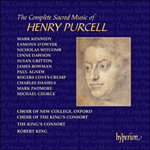 Purcell: The Complete Sacred Music Purcell: The Complete Sacred Music‘It is hard to speak too highly of this enterprise … much enjoyment to be had’ (Gramophone) ‘The performances from The King’s Consort and its Choir, the Choir of New College and a starry line-up of soloists have such qualities of concentratio ...» More |
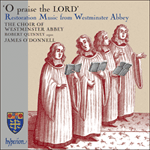 O praise the Lord O praise the LordThe Choir of Westminster Abbey under their inspirational director James O’Donnell delves into the Abbey’s vaults for this latest fascinating disc. The triumphant mood of the Restoration required much glorious liturgical music, and the Abbey was ho ...» More |
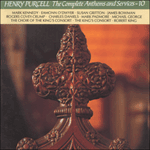 Purcell: The Complete Anthems and Services, Vol. 10 Purcell: The Complete Anthems and Services, Vol. 10‘This is an altogether exceptional undertaking, deserving of congratulations all round’ (Choir & Organ) ‘An excellent addition to a very fine series of discs’ (Cross Rhythms)» More |
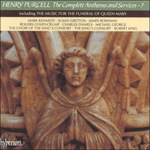 Purcell: The Complete Anthems and Services, Vol. 7 Purcell: The Complete Anthems and Services, Vol. 7‘It's difficult to imagine how this new recording could be bettered’ (Fanfare, USA)» More |
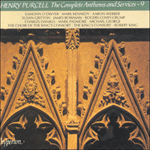 Purcell: The Complete Anthems and Services, Vol. 9 Purcell: The Complete Anthems and Services, Vol. 9‘Another distinguished release’ (Gramophone) ‘I have to give the disc a 'must have' rating’ (Fanfare, USA)» More |
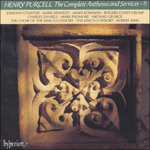 Purcell: The Complete Anthems and Services, Vol. 8 Purcell: The Complete Anthems and Services, Vol. 8‘The instrumental playing is of exceptionally high quality and the three soloists are outstanding’ (CDReview)» More |

